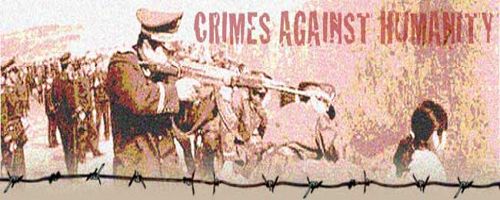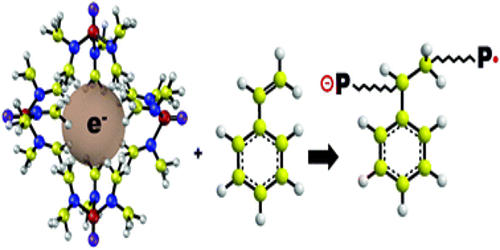Crimes Against Humanity: Atrocious acts outside and beyond the laws and customs of war (conflict) which in nature and/or scale violate all standards of reasons, dignity, and human nature. Ex: Genocide / Terrorism.
Crimes against humanity are criminal acts that target a group of people based on their religion, ethnicity, or some other trait, which is not a direct result of something that group has done. They are certain acts that are deliberately committed as part of a widespread or systematic attack or individual attack directed against any civilian or an identifiable part of a civilian population. One of the most common crimes against humanity is genocide, which is the murder of a large portion of the population. Genocide is often either condoned, or carried out by the government.
History:
The term “crimes against humanity” was used for the first time in 1915 by the Allied governments (France, Great Britain and Russia) when issuing a declaration condemning the mass killings of Armenians in the Ottoman Empire. However, it was only after World War II in 1945 that crimes against humanity were for the first time prosecuted at the International Military Tribunal (IMT) in Nuremberg. Both the Charter establishing the IMT in Nuremberg as well as that establishing the IMT for the Far East in Tokyo included a similar definition of the crime.
Since then, the notion of crimes against humanity has evolved under international customary law and through the jurisdictions of international courts such as the International Criminal Court, the International Criminal Tribunal for the former Yugoslavia and the International Criminal Tribunal for Rwanda. Many States have also criminalized crimes against humanity in their domestic law; others have yet to do so.

List of Crimes Against Humanity
Crimes against humanity consist of any act that is violent in nature and aimed at a specific section of the population. What follows is a list of crimes against humanity. This list of crimes against humanity does not contain every possible crime that can be so classified; however, the acts specified in this list of crimes against humanity are some of the more common acts defined by the term.
- Murder/Extermination (Extermination is the act of killing a larger group of people, while murder is often more individualized)
- Enslavement
- Deportation
- Torture
- Sexual violence, including rape, prostitution, forced pregnancy, or sterilization
- Persecution of a group based on politics, race, nationality, ethnicity, culture, religion, or gender
- Enforced disappearance (by either government-authorized abduction, or imprisonment)
- Apartheid (segregation of South Africa’s white and non-white populations)
Other inhumane acts of violence that are meant to intentionally cause mental or physical suffering or injury to the victims
Early development
Nuremberg Tribunal:
Despite this early use of the term, the first prosecutions for crimes against humanity took place after the Second World War in 1945 before the International Military Tribunal (IMT) at Nuremberg. The charter establishing the IMT of Nuremberg defined crimes against humanity as:
…murder, extermination, enslavement, deportation, and other inhumane acts committed against any civilian population, before or during the war, or prosecutions on political, racial or religious grounds in execution or in connection with any crime within the jurisdiction of the Tribunal, whether or not in violation of the domestic law of the country where perpetrated.
Tokyo Tribunal:
The Tokyo Charter of 1946, establishing the International Military Tribunal for the Far East, incorporated the same definition of crimes against humanity.
The International Law Commission:
After the Nuremberg and Tokyo trials of 1945-1946, the next international tribunal with jurisdiction over crimes against humanity would not be established for another five decades. However, work continued on developing the definition of crimes against humanity. In 1947, the International Law Commission was charged by the United Nations General Assembly with the formulation of the principles of international law recognized and reinforced in the Nuremberg Charter and judgment, and with drafting a ‘code of offenses against the peace and security of mankind’. Completed fifty years later in 1996, the Draft Code defined crimes against humanity as various inhumane acts, i.e., murder, extermination, torture, enslavement, persecution on political, racial, religious or ethnic grounds, institutionalized discrimination, arbitrary deportation or forcible transfer of population, arbitrary imprisonment, rape, enforced prostitution and other inhuman acts committed in a systematic manner or on a large scale and instigated or directed by a Government or by any organization or group.
International Criminal Tribunal for Rwanda (ICTR):
In 1994, the UN Security Council established the International Criminal Tribunal for Rwanda (ICTR), pursuant to the genocide that had taken place from April – July 1994. In the ICTR Statute, the linkage between crimes against humanity and an armed conflict of any kind was dropped. Rather, the requirement was added that the inhumane acts must be part of a “systematic or widespread attack against any civilian population on national, political, ethnic, racial or religious grounds”, see Article 3 of the ICTR Statute. Because of the internal nature of the conflict in Rwanda, crimes against humanity would likely not have been applicable if the nexus to armed conflict had been maintained.
Information Source:
















